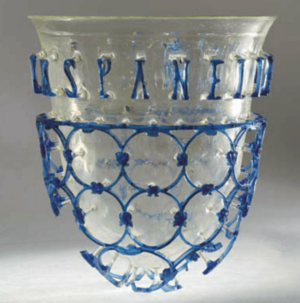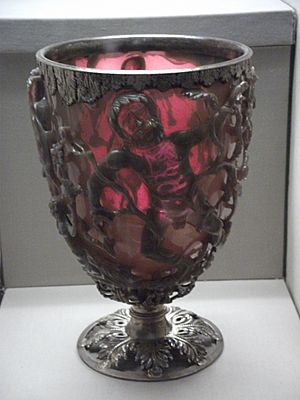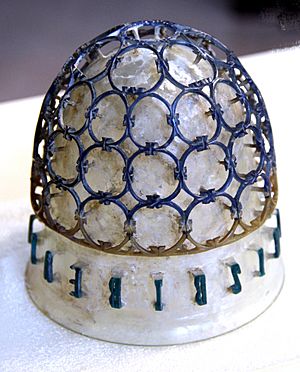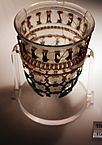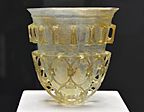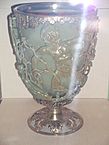Cage cup facts for kids
A cage cup is a special type of fancy glass cup made in ancient Rome, around the 4th century AD. These cups are considered some of the most amazing glass objects ever created by the Romans.
A cage cup has two main parts: an inner cup and a cool outer "cage" design. This outer cage stands out from the main cup and is connected to it by small glass pieces. Imagine a delicate net of glass around a solid cup!
Only about 50 of these cups (or pieces of them) still exist today. Most have a cage with circular patterns and sometimes words carved into them. These words are often good wishes or sayings. Some rare cage cups even show scenes with figures, like the famous Lycurgus Cup in the British Museum. This cup is special because its cage shows a story with a character named Lycurgus.
Cage cups don't have a base or foot, which is unusual for a cup. They were very hard to make and were definitely super expensive in Roman times. Experts are still trying to figure out exactly how they were made and what they were used for.
Contents
How Were Cage Cups Made?
Historians and archaeologists have long debated how these amazing cups were created. For a long time, most experts believed that cage cups were made from a single, thick piece of glass. The glassmakers would carefully cut and grind away all the extra glass, leaving behind the inner cup and the delicate outer cage. This was a very difficult and time-consuming process, similar to how ancient Romans carved precious stones.
However, a newer idea suggests that maybe only the rim and the cage patterns were cut this way. Some experts think that the inner cup and the outer cage might have been made separately. Then, they would have been joined together when the glass was very hot. This idea comes from looking closely at some cups, like the one from Cologne or Pljevlja. They seem to have very smooth joins between the cage and the cup, which might suggest they were fused together.
But this idea is still being discussed. A piece of a cage cup found in Corinth, Greece, didn't show any signs of separate parts being joined. So, the mystery of their exact making process continues!
Some cage cups are even more special because they use different colors for the cage and the inner cup. The Milan and Cologne cups are examples of this. Others, like the Lycurgus Cup, are made from a special type of glass called dichroic glass. This glass changes color depending on how the light shines through it – it's like magic!
What Were Cage Cups Used For?
The purpose of cage cups is another big question for experts. Many of the cups have inscriptions or sayings carved on them, like "Drink, live well forever" or "Drink and you will live for many years." These messages suggest they were used for drinking, perhaps during special events or celebrations.
However, some experts believe that not all cage cups were for drinking. Some, like the one at the Corning Museum of Glass, have a wider, bowl-like shape and an out-turned rim. This cup was found with metal fittings that suggest it was hung up. This means it might have been an oil lamp designed to be suspended, lighting up a room.
So, it's possible that cage cups were used for different things. Some might have been elegant drinking vessels for important gatherings. Others, especially the wider ones, might have been beautiful hanging lamps.
Where Did Cage Cups Come From?
High-quality Roman glass was often thought to come from big cities like Rome or Alexandria in Egypt. However, most cage cups have been found in Roman sites along the Rhine River in Europe. This suggests that they might have been made in that area.
Cities like Trier (which was called Augusta Treverorum in Roman times) or Cologne (Colonia Claudia Ara Agrippinensium) are possible places where these cups were made. Trier was a very important city in Roman Germany and a main home for Emperor Constantine the Great when these cups were being made.
More recently, some cage cups have been found in the Eastern part of the Roman Empire. This makes experts wonder if there were two different places where these amazing glass cups were produced.
Famous Cage Cups
Here are some of the best-preserved cage cups that have survived:
- The Cologne Cage Cup: Found in Cologne, Germany. It has Greek words that mean: "Drink, live well forever."
- The Coppa diatreta Trivulzio: Located in Milan, Italy. This is the only known cage cup that is completely undamaged! It says: "Drink and you will live for many years."
- The Munich Cup: Found in Cologne, but now in Munich, Germany. It also has a similar message: "Drink for many years."
- The Lycurgus Cup: This cup is very special because its glass changes color depending on the light. It doesn't have words, but it shows a scene with figures.
- The Pljevlja Cage Cup: Found in Montenegro. It has a clear body and a blue cage with an inscription that wishes someone well.
- The Corning Cage Cup: This cup is wider, like a bowl, and is in Corning, New York. It was found with parts that show it was likely hung up as a lamp.
- The Constable-Maxwell Cup: Another wide, bowl-shaped example. It has been sold for record-breaking prices, showing how valuable these ancient glass items are.
-
Fragments found in Tunisia, the first from North Africa.
Images for kids
See also
 In Spanish: Diatreta para niños
In Spanish: Diatreta para niños


